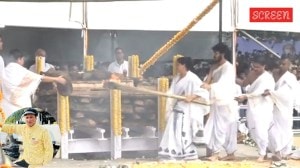In Kipling Country
There is something about Rudyard Kipling’s Kim that sets the gypsy free. And with the imperialist being the flavour of the season (chec...

There is something about Rudyard Kipling’s Kim that sets the gypsy free. And with the imperialist being the flavour of the season (check out David Gilmour’s recent biography The Long Recessional), there is no better time to follow the Kipling Trail and rediscover the ‘river of life,’ as he called the Grand Trunk Road, the colourful village folk who breathed that vital spark into it, their lush green acres, and Umballa (that is the way Kipling spelt it), where Kim spent many agonising days as a very unwilling sahib and, last but not the least, Simla, where he met master artificer Lurgan Sahib.
| At Home in the Hills |
|
IF Punjab was where Kipling’s imagination found a home, Shimla was where it took flight. Many of the Chhota Vilayat landmarks that Kipling mentions in Kim are non-existent. Says historian and writer Raja Bhasin, ‘‘There is no evidence that the curio shop, for instance, that Kipling wrote about ever existed. But he could have based the shop on one owned by A M Jacob, a diamond merchant who also provided the inspiration for Lurgan sahib, in the Hamilton building near the lift in downtown Shimla.’’ Plaity’s restaurant is another ‘inspired’ invention in Kim. Bhasin believes it was based on Regent House, also located near the lift. One part of Shimla that was no fiction is the North Bank building. This is where Kipling always put up while in town; this is where he wrote his Plain Tales from the Hills. Though much has changed in the erstwhile capital of the British Raj, what still remains appropriate is Kipling’s description of the Lower Bazaar. As shoppers will testify, it is still a ‘‘rabbit-warren at an angle of forty-five.’’ |
Of the sprawling paraos (overnight camps) that Kipling described as ‘‘a line of stalls selling very simple food and tobacco, a stack of firewood, a police station, a well, a horse-trough…’’ there is no sign. These have been replaced by pocket-cum-palate-friendly dhabas and food joints. But then we spy the remains of parao at Jharmari village in Lalru. The Pracheen Shiv Man-dir stands on the site with a well, which the priest tells us was dug at the time of Queen Victoria.
Time has changed Kipling’s Umballa as well: The racecourse where Kim held his secret meetings with Mahbub Ali is now history. St Paul’s Cathedral, which dates back to 1857, lies in ruins in the middle of the Air Force Public School. ‘‘It was bombed during the ’65 war,’’ explains the sentry helpfully before shutting the gates on our face. ‘‘Sorry, no photos, it’s the cantonment,’’ he yells.
But Rev H D Lall next door is more helpful. History lives on in his compound. You can hear it in the bell installed outside. ‘‘It came from the belfry of the cathedral,’’ his wife says.
Fortified with these little nuggets from the past, we renew our search for those airy barracks and houses Kipling described in passing. The rush of enthusiasm makes every rickety old barrack look like a Kiplingesque relic till a wise Air Force man drags us to the present with a reminder that all these buildings are of 20th century vintage. ‘‘Um… the railway station,’’ he scratches his chin, ‘‘is really old.’’
Eternally hopeful, we dash off to the station to meet a youthful section engineer Vivek Kalia, who disappoints us with: ‘‘I am only 10 years old here.’’ So are the others, though a grizzled toothless peon mumbles that the station dates back to 1857. Scenting no history except in the wooden beams, we weave through a sea of humanity — some Gurkha soldiers, a family from down South, some sleeping labourers from UP — Kim would have been proud to rub shoulders with, before finally getting on to GT Road, hearts pounding with expectation.
Kipling had called it ‘‘the backbone of all Hind… with four lines of trees dividing the road into three. A man goes in safety here — for at every few koss is a police station… such a river of life as nowhere else exists in the world.’’ It is here that he met ‘‘strong-scented sansis, a gang of changars, a lone Akali.’’ Alas, what we find is a sea of vehicles — from the democratic Maruti and rustic tractor-trolley to the snooty Mercedes, all jostling for the same bit of tarmac.
A trifle disappointed, we look, a la Kim, for ‘‘new people, new sights.’’ A blue-turbaned Nihang beckons from a distance, and we slip into a path leading to Nanhera village. Our object of curiosity disappears, but a police post has us applying the brakes. ‘‘Most of people here are settlers from outside,’’ says the Munshi Chander Shekhar, putting paid to our hopes of finding a 100-year-old with an elephantine memory.
But a minute later, we are drowning our disappointment in hot cuppas ordered by the cops. In fact, one thing that has not changed since Kipling’s time is rural hospitality. A chat means a cup of tea, never mind if you are a stranger.
We discover this once again when we drive into Shahpur village a few km on to meet sarpanchni Baljinder Kaur. She guides us to a dharamshala, where village elders gather every day. But no, they do not smoke Kipling’s hookah. It has been usurped by more potent intoxicants. ‘‘Our village is notorious for nasha and killings,’’ Baljinder laments.
Now that is what Kim would have loved. And so we return. After a hot cuppa, of course.
Photos



- 01
- 02
- 03
- 04
- 05




























